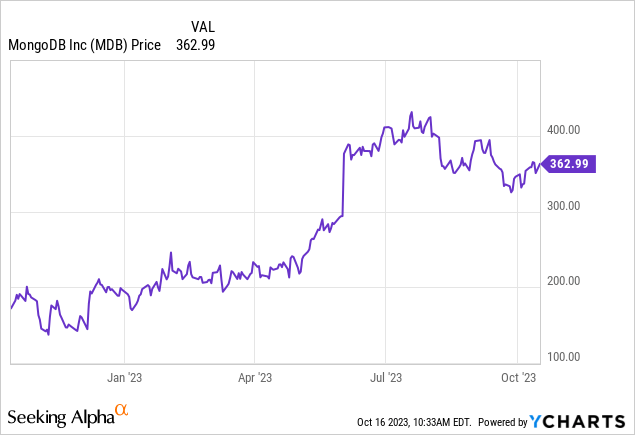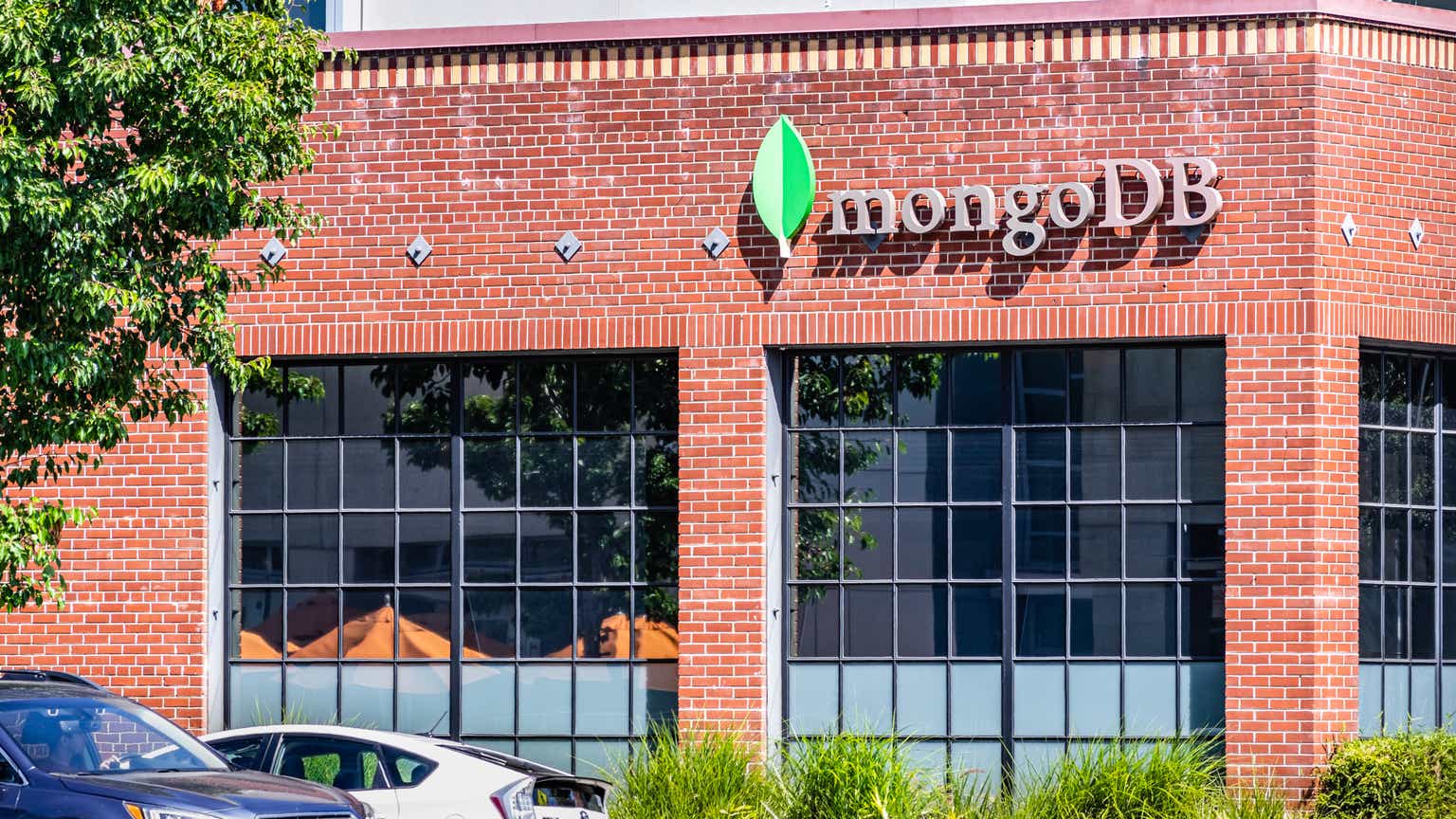For MongoDB (NASDAQ:MDB), it’s almost like there has been no recession in the works over the past year. The non-relational database company has exceeded expectations in 2023, with revenue growth surging despite a flagging economy. While most other enterprise software peers are reporting decaying sales cycles and increased competition, MongoDB has continued to buck the trend. The company’s progress in building out a fuller ecosystem for AI products also certainly doesn’t hurt.
Yet we do have to ask ourselves: how much of this strength is already priced in? Year to date, shares of MongoDB are up nearly 2x already:

Valuation is the main drag here, especially in a high interest rate environment
I last wrote on MongoDB in June when the stock was trading near $390, issuing a neutral opinion (a downgrade from a prior bullish position). Since then, the stock has declined nearly 10%, and it has released very strong Q2 results that featured a re-acceleration in revenue growth. To me, that’s a usual formula for a buy.
But I also can’t ignore the macro. Even if the slowdown isn’t necessarily hurting MongoDB’s sales momentum, it does weigh on MongoDB’s stock – especially when risk-free interest rates have climbed above 5%. Over the course of the past year, I have substantially reduced my allocation to equities and dumped more into short-term U.S. treasuries, making exceptions only for high-quality “growth at a reasonable price” stocks. MongoDB is high-growth and high-quality, but its price is anything but reasonable.
At current share prices near $363, MongoDB trades at a market cap of $25.89 billion. After we net off the $1.90 billion of cash and $1.14 billion of convertible debt off MongoDB’s most recent balance sheet, the company’s resulting enterprise value is $23.99 billion.
Meanwhile, for the current fiscal year MongoDB has guided to $1.596-$1.608 billion in revenue:

MongoDB outlook (MongoDB Q2 earnings release)
This puts MongoDB’s valuation at 15.0x EV/FY24 revenue.
Even if we roll forward multiples to next year, MongoDB remains expensive. Wall Street analysts are expecting MongoDB to generate $1.97 billion in revenue in FY25 (the year for MongoDB ending in January 2025, and representing 22% y/y growth; data from Yahoo Finance). Against FY25 estimates, MongoDB still trades at 12.2x EV/FY25 revenue.
I’m not comfortable anywhere above a high single-digit revenue multiple for MongoDB against FY25 estimates. I’d consider buying the stock again if it hits 9x EV/FY25 revenue, representing a price target of $260 and ~28% downside from current levels (where MongoDB was trading in the May timeframe).
And in light of MongoDB’s huge valuation, we should also be wary of several fundamental risks the company is susceptible to:
- GAAP losses are still large- Though MongoDB has notched positive pro forma operating and net income levels, the company is still burning through large GAAP losses because of its reliance on stock-based compensation. In boom times investors may look the other way, but in this more cautious market environment MongoDB’s losses may stand out.
- Consumption trends may falter- MongoDB prices by usage and by workload. Other companies like Snowflake (SNOW) have reported weaker consumption in the current macro; while MongoDB seems unimpacted so far, this may catch up in the near future.
- Competition- MongoDB may have called itself an “Oracle killer” at the time of its IPO, but Oracle (ORCL) is also making headway in autonomous and non-relational databases. Given Oracle’s much broader software platform and ease of cross-selling, this may eventually cut into MongoDB’s momentum.
All in all, I’m happy to remain on the sidelines here. Continue to watch and wait here until MongoDB drops to the right buying levels.
Q2 download
This being said, we should acknowledge the strength in MongoDB’s latest quarterly results, which were released at the very tail end of August. The Q2 earnings summary is shown below:

MongoDB Q2 results (MongoDB Q2 earnings release)
Revenue grew 40% y/y to $423.8 million, dramatically outpacing Wall Street’s expectations of $390.9 million (+29% y/y) by a huge eleven-point margin. Revenue growth also accelerated eleven points versus 29% y/y growth in Q1, as well as 36% y/y growth in Q4.
What makes this even more impressive is that MongoDB’s consumption-based pricing is what many investors had suspected would make MongoDB vulnerable in the current macro. Snowflake is the best example here of a similarly-sized software company that doesn’t price per seat, but by client usage. The company has seen tremendous deceleration owing to the fact that customers have slowed down their usage of the platform amid budget cuts and macro constraints. Clearly, however, it’s not “one size fits all” and MongoDB managed to escape the pain.
Reflecting on consumption trends in the business on the Q2 earnings call, CFO Michael Gordon noted as follows:
Consumption growth in Q2 was slightly better than our expectations. As a reminder, we had assumed Atlas would continue to be impacted by the difficult macro environment in Q2, and that is largely how the quarter played out.
Turning to non-Atlas revenues. EA significantly exceeded our expectations in the quarter, and we continue to have success selling incremental workloads into our EA customer base. We continue to see that our customers, regardless of their mode of deployment, are launching more workloads at MongoDB and moving towards standardizing on our platform. The EA revenue outperformance was in part a result of more multiyear deals than we had expected. In addition, we had an exceptionally strong quarter in our other licensing revenues.”
It was also a strong quarter for new logo adds, as MongoDB added 1,900 new customers to the fold.
Optimization of the company’s sales coverage has also helped boost efficiency and margins. The company is tracking customer consumption trends to determine which customers need to be covered by sales reps or moved to the self-service direct channel. In Q2, the company elected to migrate 300 lower-tier customers into the direct channel.
Savings on opex alongside strong revenue growth helped MongoDB generate $79.1 million in pro forma operating income, representing a 19% margin – 23 points better than a -4% operating margin in the year-ago Q2. We note that MongoDB scores very highly on the “Rule of 40” scale, with 40% revenue growth stacked on top of a 19% pro forma operating margin, besting most other software companies near its size.
Key takeaways
There can be little doubt that MongoDB’s execution in a difficult environment has been tremendous. That strength is what prevents me from being too bearish on the stock and why I think there likely isn’t too much downside from here. Admittedly, my price target of $260 may be difficult to reach – but at the same time, with MongoDB’s strength already priced into its stock amid a high interest-rate environment, I also don’t see much upside to the stock from here. The bottom line here: keep a close eye on this stock, but don’t make any moves just yet.
Read the full article here













